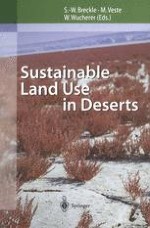2001 | OriginalPaper | Chapter
Irrigation and Land Degradation in the Aral Sea Basin
Authors : Nicolai Orlovsky, Michael Glantz, Leah Orlovsky
Published in: Sustainable Land Use in Deserts
Publisher: Springer Berlin Heidelberg
Included in: Professional Book Archive
Activate our intelligent search to find suitable subject content or patents.
Select sections of text to find matching patents with Artificial Intelligence. powered by
Select sections of text to find additional relevant content using AI-assisted search. powered by
The Aral Sea basin has experienced the development of large-scale irrigation since the 1940s–1950s. This policy has resulted in an increased area of secondary salinized lands and other lands unsuitable for cultivation under conditions of a limited supply of irrigating water. The natural environment was seriously damaged, including a lowering of the Aral Sea level and deterioration in the living conditions of the local population. For a long time the population in the area and large segments of the scientific community were misinformed about or unaware of the real ecological state of the region. This, coupled with the Soviet Command and Control system of government, made it difficult, if not impossible, to take the necessary action toward environmental remediation.At present the Aral basin hosts a very complicated system of canals, reservoirs, irrigated fields and hydrotechnical construction including 7.9 million ha of irrigated lands, 323 200 km of irrigation network and 161 800 km of collectors and drains. In spite of such a wide scale of water construction, irrigation techniques themselves are the same as in Middle Ages — border and furrow irrigation. Under such a system of land use, water loss in agriculture is up to one-fifth of the total water intake for irrigation.The total volume of drainage water from the Aral Sea basin is more than 33 km3 a−1. Of this volume, more than 20 km3 a−1 returns to the rivers and about 13 km3 a−1 flows to large depressions or other chaotic areas in desert pastures.Improper irrigation leads to secondary salinization, waterlogging, and, eventually, desertification. Diversion of drainage water to the rivers results in deterioration of river water quality; diversion to the marginal desert areas results in waterlogging of pastures and environmental degradation of the total area.
